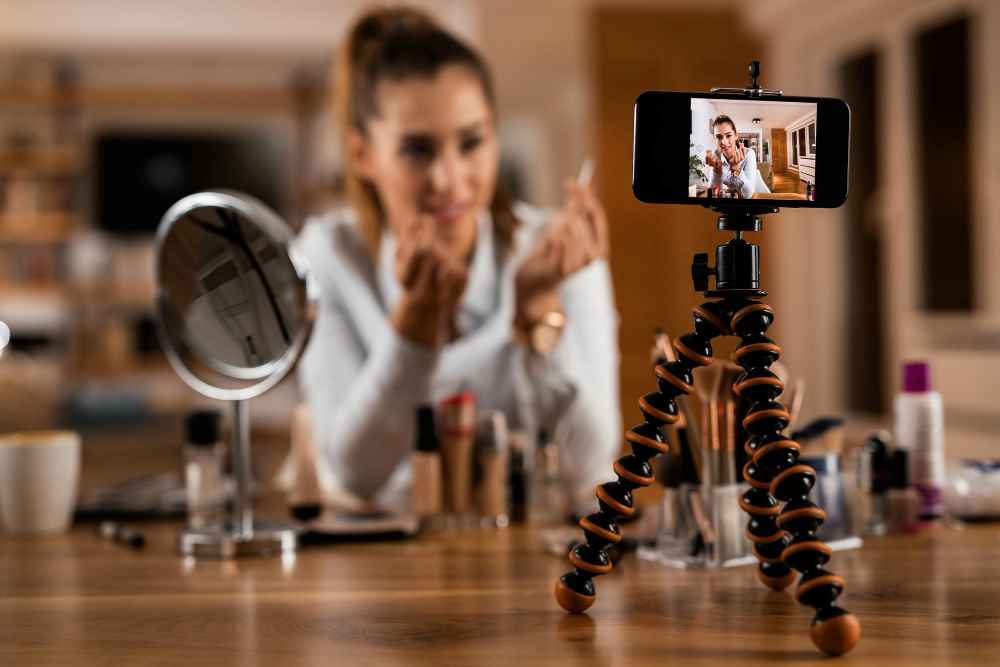Unleashing the Potential of Influencer Marketing for Small Business Success
Influencer marketing is more than just a trend—it’s a transformative tool. For small businesses, it’s the secret to achieving significant growth. If you’re not utilizing influencer marketing, you’re missing out on a powerful strategy that can elevate your brand to the next level.
Why Influencer Marketing is a Must-Have for Small Businesses

As a small business owner, it can be tough to get people to notice and trust your brand. This is where influencer marketing can make a big difference.
Influencer marketing is when you work with people who have a strong following on social media or other online platforms. These influencers talk about your products or services to their audience, which helps more people learn about your business. But it’s not just about getting noticed; it’s also about building trust quickly. When an influencer, someone their followers already trust, recommends your brand, it instantly makes your business more credible.
Now, here’s something surprising: Influencer marketing can be much more effective than traditional advertising. Studies show that businesses get 11 times more return on investment (ROI) from influencer marketing than from regular online ads. That means for every dollar you spend on influencer marketing, you could get back 11 times more value than you would from other forms of advertising.
This is especially important for small businesses with tight budgets. Instead of spending a lot of money on ads that may not work, you can use influencer marketing to get better results for less money. It’s a smart, cost-effective way to grow your business and reach more customers.
Why Influencer Marketing is a Budget-Friendly Option for Small Businesses

Traditional advertising, like TV commercials or magazine ads, can be very expensive, and there’s no guarantee that they will bring in customers. This can be a big challenge, especially for small businesses with limited budgets.
Influencer marketing, however, is a much more affordable option that can deliver real, measurable results. Instead of spending a lot of money on ads that might not work, you can partner with influencers who promote your products or services to their followers. This approach allows you to reach more people without breaking the bank.
You don’t need to spend millions to make an impact. Working with “micro-influencers”—those with smaller, but highly engaged, audiences—can be incredibly effective. These micro-influencers often have a closer connection with their followers, which means their recommendations are trusted and more likely to lead to sales.
In simple terms, influencer marketing is a cost-effective way to advertise your business. It allows you to get more value for your money and see real results without needing a huge budget.
Micro-Influencers: The Secret Advantage for Small Businesses

As a small business owner, you might think that you need to work with celebrities or people with millions of followers to promote your products. But here’s a surprising truth: micro-influencers—those with 1,000 to 100,000 followers—can actually be more effective for your business.
Micro-influencers are often everyday people who have built a loyal and engaged community around a specific interest or niche. Because their audience is smaller, they tend to have a closer relationship with their followers. This means that when they talk about a product or service, their followers are more likely to pay attention and take action.
For small businesses, this is great news. Micro-influencers are not only more affordable to work with, but they also deliver better results. Their followers trust their recommendations, leading to higher engagement—more likes, comments, and, most importantly, more sales.
In simple terms, micro-influencers are like hidden gems. They offer a powerful way to promote your business without the high costs associated with big-name influencers. By working with them, you can reach a highly interested audience that is more likely to support your business.
Real-Life Example: How Glossier Became a Global Brand with Influencer Marketing
Let’s look at a real-life example of how a small brand used influencer marketing to become hugely successful. Glossier, a well-known beauty brand today, started out as a simple blog about beauty and skincare.
In the beginning, Glossier didn’t have a big advertising budget. Instead, they focused on using micro-influencers—everyday people with a small but dedicated following on social media. These influencers genuinely loved Glossier’s products, so they shared their experiences with their followers. Because these recommendations came from people who were trusted by their audience, it created a lot of excitement and buzz around the brand.
This strategy of using micro-influencers worked so well that Glossier quickly gained a large and loyal customer base. As more people started talking about Glossier products, the brand grew rapidly. Today, Glossier is a global brand, all thanks to the power of influencer marketing.
For a small business like yours, this example shows how you don’t need a huge budget or famous celebrities to succeed. By partnering with micro-influencers who genuinely like your products, you can create the same kind of buzz and grow your business just like Glossier did.
Choosing the Right Influencers: A Critical Decision for Your Business

As a small business owner, selecting the right influencers to promote your products is crucial. This decision can either boost your business or waste your resources.
First, it’s important to understand that not all influencers are the same. Just because someone has a large number of followers doesn’t mean they’re the best fit for your business. Instead of focusing solely on how many followers an influencer has, you should consider other important factors.
- Alignment with Your Brand Values: The influencer you choose should share the same values and message as your brand. For example, if your business focuses on eco-friendly products, you want to work with an influencer who is passionate about sustainability. This ensures that their promotion of your products feels genuine and resonates with their audience.
- Target Audience: It’s essential to choose influencers whose followers match your target customers. If you’re selling a product aimed at young parents, for instance, you’ll want to partner with an influencer who is popular among that group. This way, your product reaches the people most likely to be interested in it.
- Engagement Rate: An influencer’s engagement rate is how actively their followers interact with their content—through likes, comments, and shares. An influencer with a smaller but highly engaged audience can be more effective than one with a large but less involved following. High engagement shows that the influencer’s followers trust them and value their opinions.
- Authenticity: Lastly, the influencer should be authentic. This means they genuinely care about and use the products they promote. Followers can easily tell if an influencer is promoting something just for the money, and this can hurt your brand’s reputation. Choosing an influencer who truly believes in your product will lead to more credible and effective promotion.
Choosing the right influencer is about more than just their follower count. It’s about finding someone who aligns with your brand, reaches your target audience, and has genuine engagement and authenticity. Getting this right can make a huge difference in the success of your influencer marketing efforts.
The Importance of Authenticity: Why It Matters for Your Business

As a small business owner, it’s essential to understand the power of authenticity in marketing. Simply put, authenticity means being genuine and real. When it comes to influencer marketing, this is especially important.
People today are smart—they can quickly tell if someone is promoting a product just for the money. If an influencer talks about your product but doesn’t really use it or believe in it, their followers will sense that it’s not genuine. This can actually harm your business because people might not trust the recommendation.
On the other hand, when an influencer genuinely loves and uses your product, their promotion feels authentic. Their followers can see that the influencer truly believes in what they’re sharing. This builds trust between the influencer and their audience, and that trust extends to your brand.
When people trust the recommendation, they are more likely to buy the product. This is why authentic endorsements—those that come from a real place of liking the product—are so powerful. They don’t just bring attention to your business; they help you build a loyal customer base that believes in your brand.
In short, authenticity matters because it leads to trust, and trust leads to more sales. By working with influencers who genuinely like and use your product, you can create a more believable and effective marketing campaign that benefits your business in the long run.
Why Engagement Matters More Than Reach in Influencer Marketing

As a small business owner, you might think that the key to successful marketing is reaching as many people as possible. This is a common belief, but it’s not entirely accurate when it comes to influencer marketing.
Reach refers to the number of people who see an influencer’s content. While it’s important to get your product in front of a large audience, reach alone doesn’t guarantee success. Just because millions of people see a post doesn’t mean they’re interested in your product or will take action, like making a purchase.
Engagement, on the other hand, refers to how actively the audience interacts with the influencer’s content. This includes likes, comments, shares, and other forms of interaction. High engagement shows that the audience is not just seeing the content—they’re interested in it and connected to the influencer.
Here’s the important part: Influencers with smaller but highly engaged audiences can be more effective for your business than those with millions of passive followers. This is because an engaged audience is more likely to trust the influencer and act on their recommendations. In other words, these followers are more likely to buy your product because they value the influencer’s opinion.
For example, if an influencer has 10,000 followers who are very engaged, their recommendation could lead to more sales for your business than an influencer with 1 million followers who don’t interact much with the content.
So, instead of just looking at how many people an influencer can reach, focus on how engaged their audience is. An influencer with a smaller but more involved and interactive audience can drive better results for your business, leading to more customers and sales. In influencer marketing, engagement is the true measure of success.
How to Approach Influencers: The Right Way to Work Together
As a small business owner, you may be interested in working with influencers to promote your products or services. However, reaching out to influencers isn’t as simple as just sending a message. It requires a thoughtful approach to get the best results.
- Be Personal: When you approach an influencer, make sure your message is personalized. Don’t send the same generic message to everyone. Take the time to learn about the influencer, their content, and why they would be a good fit for your brand. Mention specific things you like about their work and explain how your product or service aligns with their audience. This shows that you value their uniqueness and makes them more likely to want to work with you.
- Offer Value: Influencers receive many collaboration requests, so it’s important to offer something valuable in return. This could be free products, a commission on sales, or a unique experience related to your brand. Think about what would appeal to the influencer and make them excited to work with you. Offering something of value shows that you appreciate their time and effort.
- Build Long-Term Relationships: Don’t just think of influencer marketing as a one-time thing. Building long-term relationships with influencers can lead to better results over time. When influencers consistently talk about your brand, their audience becomes more familiar with and trusting of your products. This ongoing relationship can lead to more sales and a stronger brand presence.
In simple terms: When you approach influencers, be personal and thoughtful. Show them that you’ve taken the time to understand their work and offer them something valuable in return. By building long-term relationships, you can create a partnership that benefits both your business and the influencer. This careful approach will help you get the most out of your influencer collaborations.
Measuring Success in Influencer Marketing: The Metrics That Really Matter

As a small business owner, it’s important to know if your influencer marketing efforts are actually working. To do this, you need to track certain key metrics, which are like measurements that tell you how well your campaign is doing.
- Engagement Rate: This measures how much people interact with the influencer’s content about your brand. It includes actions like likes, comments, shares, and clicks. A high engagement rate means people are interested and paying attention, which is a good sign that your campaign is working.
- Conversion Rate: This is perhaps the most important metric. It measures how many people take a specific action after seeing the influencer’s content, like making a purchase or signing up for your service. A high conversion rate shows that the influencer’s promotion is directly leading to sales or other valuable actions for your business.
- ROI (Return on Investment): ROI tells you how much profit you’re making compared to how much you spent on the influencer campaign. For example, if you spent $100 on a campaign and made $500 in sales, your ROI is very positive. It’s important to know your ROI so you can see if the campaign was worth the investment.
Avoid Focusing on Vanity Metrics: Vanity metrics are things like the number of likes or shares that a post gets. While these can look impressive, they don’t always mean that people are buying your product or engaging deeply with your brand. It’s more important to focus on metrics that show real results, like engagement rate, conversion rate, and ROI.
In simple terms: To know if your influencer marketing is working, keep an eye on how engaged people are with the content, how many of them are taking actions like buying your product, and whether the money you’re spending is bringing in more money in return. These are the true signs of success in an influencer campaign.
Shocking Statistics: 70% of Millennials Trust Influencers More Than Celebrities
Millennials are driving the influencer marketing boom. They trust influencers more than traditional celebrities, making influencer marketing an indispensable strategy for small businesses targeting this demographic.
Overcoming Common Challenges in Influencer Marketing: A Guide to Success

As a small business owner, you might be excited about the potential of influencer marketing, but it’s important to know that there are some challenges involved. However, with the right approach, these challenges can be managed effectively, leading to successful outcomes for your business.
Challenge 1: Finding the Right Influencers One of the biggest challenges is choosing the right influencers to work with. Not every influencer will be a good fit for your brand. You need to find someone whose audience matches your target customers and who genuinely aligns with your brand values. This takes time and research, but it’s worth the effort to find the right partner.
Solution: Take your time to research influencers. Look at their content, their audience, and how they interact with their followers. This will help you find influencers who can truly represent your brand and connect with your target market.
Challenge 2: Measuring ROI (Return on Investment) It can be difficult to measure how much return you’re getting from your investment in influencer marketing. Knowing if the money you spend on an influencer is actually bringing in sales or valuable leads is crucial for your business.
Solution: Track important metrics like engagement rate (how much people interact with the content), conversion rate (how many people take action after seeing the content), and ROI itself. By closely monitoring these numbers, you can see what’s working and make adjustments as needed.
Challenge 3: Managing the Campaign Running an influencer marketing campaign involves a lot of moving parts, from creating content to managing relationships with influencers. This can be overwhelming, especially if you’re new to this type of marketing.
Solution: Plan your campaign carefully. Set clear goals, create a detailed plan, and communicate regularly with the influencers you’re working with. By staying organized and focused, you can manage the campaign more effectively.
Influencer marketing comes with its own set of challenges, such as finding the right influencers and measuring your success. However, with careful planning, research, and attention to detail, you can overcome these obstacles and achieve great results for your small business. Don’t be discouraged by the challenges—use them as opportunities to learn and improve your strategy.
The Future of Influencer Marketing: What Small Businesses Need to Know
As a small business owner, it’s important to understand that influencer marketing is always changing. What works today might not be as effective tomorrow, so it’s crucial to stay updated on the latest trends to keep your business competitive.
Video Content is on the Rise One of the biggest changes in influencer marketing is the growing importance of video content. Platforms like TikTok and Instagram are becoming more popular, and they are heavily focused on short, engaging videos. These videos are a powerful way to grab attention and connect with potential customers quickly.
Why Video Matters People are spending more time watching videos online, and they are more likely to engage with video content compared to text or images. This means that influencers who create compelling videos can reach and influence more people. For your business, this is an opportunity to showcase your products or services in a more dynamic and appealing way.
Staying Ahead of the Trends To make the most of influencer marketing, you need to keep up with these trends. This doesn’t mean you have to be on every new platform, but it does mean you should pay attention to where your target audience is spending their time. If they are watching videos on TikTok or Instagram, it’s worth considering working with influencers who are active on these platforms.
In simple terms: The future of influencer marketing is shifting towards video content, especially on platforms like TikTok and Instagram. To keep your business competitive, it’s important to stay informed about these changes and adapt your strategy accordingly. By embracing new trends, you can continue to reach and engage with your audience effectively.
Understand This: Success is All About the Details
When it comes to influencer marketing, every little detail counts. Think of it like putting together a puzzle—each piece needs to fit perfectly to see the full picture. From choosing the right influencers to tracking how well your campaign is doing, paying attention to these details is crucial.
Why It Matters:
- Choosing the Right Influencers: This is the foundation of your strategy. The right influencers will connect with your target audience and genuinely promote your product. If you get this wrong, your campaign might not be as effective.
- Measuring Your ROI (Return on Investment): This tells you if your investment in influencer marketing is paying off. By tracking things like sales and engagement, you can see what’s working and what isn’t, allowing you to make adjustments and improve your results.
Getting these details right makes all the difference.
If you carefully plan and execute each step of your influencer marketing strategy, the results will speak for themselves. You’ll see increased brand awareness, more customers, and higher sales. By focusing on these key details, your small business can achieve remarkable success with influencer marketing.
Take Action: Now is the time to embrace influencer marketing and take your business to the next level. By following these principles and paying close attention to every detail, you can transform your brand’s future and achieve the growth you’ve been aiming for.
